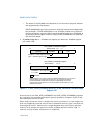
11-30 Vol. 3
MEMORY CACHE CONTROL
The discussion of write ordering in Section 8.2, “Memory Ordering,” gives a detailed
description of the operation of the store buffer.
11.11 MEMORY TYPE RANGE REGISTERS (MTRRS)
The following section pertains only to the P6 and more recent processor families.
The memory type range registers (MTRRs) provide a mechanism for associating the
memory types (see
Section 11.3, “Methods of Caching Available”) with physical-
address ranges in system memory. They allow the processor to optimize operations
for different types of memory such as RAM, ROM, frame-buffer memory, and
memory-mapped I/O devices. They also simplify system hardware design by elimi
-
nating the memory control pins used for this function on earlier IA-32 processors and
the external logic needed to drive them.
The MTRR mechanism allows up to 96 memory ranges to be defined in physical
memory, and it defines a set of model-specific registers (MSRs) for specifying the
type of memory that is contained in each range.
Table 11-8 shows the memory types
that can be specified and their properties; Figure 11-4 shows the mapping of physical
memory with MTRRs. See Section 11.3, “Methods of Caching Available,” for a more
detailed description of each memory type.
Following a hardware reset, the P6 and more recent processor families disable all the
fixed and variable MTRRs, which in effect makes all of physical memory uncacheable.
Initialization software should then set the MTRRs to a specific, system-defined
memory map. Typically, the BIOS (basic input/output system) software configures
the MTRRs. The operating system or executive is then free to modify the memory
map using the normal page-level cacheability attributes.
In a multiprocessor system using a processor in the P6 family or a more recent
family, each processor MUST use the identical MTRR memory map so that software
will have a consistent view of memory.
NOTE
In multiple processor systems, the operating system must maintain
MTRR consistency between all the processors in the system (that is,
all processors must use the same MTRR values). The P6 and more
recent processor families provide no hardware support for
maintaining this consistency.
Table 11-8. Memory Types That Can Be Encoded in MTRRs
Memory Type and Mnemonic Encoding in MTRR
Uncacheable (UC) 00H
Write Combining (WC) 01H
Reserved* 02H


















